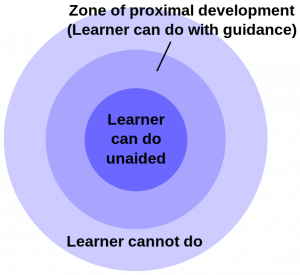2.6: 1930s: Vygotsky
- Page ID
- 77344
\( \newcommand{\vecs}[1]{\overset { \scriptstyle \rightharpoonup} {\mathbf{#1}} } \) \( \newcommand{\vecd}[1]{\overset{-\!-\!\rightharpoonup}{\vphantom{a}\smash {#1}}} \)\(\newcommand{\id}{\mathrm{id}}\) \( \newcommand{\Span}{\mathrm{span}}\) \( \newcommand{\kernel}{\mathrm{null}\,}\) \( \newcommand{\range}{\mathrm{range}\,}\) \( \newcommand{\RealPart}{\mathrm{Re}}\) \( \newcommand{\ImaginaryPart}{\mathrm{Im}}\) \( \newcommand{\Argument}{\mathrm{Arg}}\) \( \newcommand{\norm}[1]{\| #1 \|}\) \( \newcommand{\inner}[2]{\langle #1, #2 \rangle}\) \( \newcommand{\Span}{\mathrm{span}}\) \(\newcommand{\id}{\mathrm{id}}\) \( \newcommand{\Span}{\mathrm{span}}\) \( \newcommand{\kernel}{\mathrm{null}\,}\) \( \newcommand{\range}{\mathrm{range}\,}\) \( \newcommand{\RealPart}{\mathrm{Re}}\) \( \newcommand{\ImaginaryPart}{\mathrm{Im}}\) \( \newcommand{\Argument}{\mathrm{Arg}}\) \( \newcommand{\norm}[1]{\| #1 \|}\) \( \newcommand{\inner}[2]{\langle #1, #2 \rangle}\) \( \newcommand{\Span}{\mathrm{span}}\)\(\newcommand{\AA}{\unicode[.8,0]{x212B}}\)
Vygotsky: Sociocultural Theory

Figure 1. An adolescent working with a tutor through guided participation. (Photo Credit: Andrea Piacquadio, Pexels License)
Lev Vygotsky’s Zone of Proximal Development

Figure 2. A simple visualization of the zone of proximal development.

Figure 3. A park ranger teaching children.
- This chapter is an adaptation of Child Growth and Development by Paris, Ricardo, and Rymond, and is used under a CC BY 4.0 license. ↵
- This section is an adaptation of Children’s Development by Ana R. Leon, used under a CC BY 4.0. license.↵
- Vygotsky, L. (1978). Mind in society: The development of higher psychological processes. Harvard University Press. ↵


